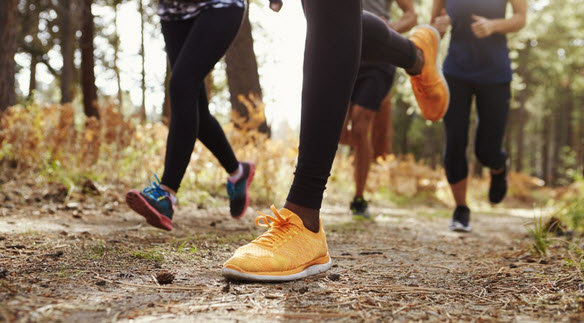As the crisp air of autumn makes its entrance, there’s no better time to enjoy trail running. Whether you’ve never stepped foot on a trail or are an avid runner, the trails are a place of equal opportunity, and the time to give them a try is now. So, lace up your running shoes and listen to some of the awesome benefits of trail running.
Calms the mind
Trail running provides a calming escape from what can be an overwhelming day. Trade the outside environment of cars and city noises for birds chirping and trees rustling. Running the trails also causes you to slow down. Although your body is in motion, being aware of the possible uneven terrain makes for a slower run and the ability to be more aware of the beauty around you. The “feel good” hormones that naturally get released when working out, are intensified as it’s said that being in nature can help ease anxiety and the feeling of rumination or sadness.
Less impact on joints
Trail surfaces are typically softer than that of pavement or concrete. As a result, less force is being applied to your body from the running surface, specifically your legs, resulting in lower impact and lower stress. Varying the surfaces that you run on throughout your training may help prevent injuries that occur due to overuse and impact.
Burns more calories
All types of running are great! But, trail running on its uneven surface can increase your calories burned up to 10 percent. This is especially true if you are accustomed to running on a treadmill or flat surface. As stated above, the changes in the terrain will require more muscle fibers to help you balance and find your footing. Most likely, your trail will have some sort of incline which raises the heart rate and burns more calories. In fact, many trails consist of embedded steps and bridges that are great calories blasters.
Builds a stronger and tighter core
Your legs aren’t the only body parts that get a workout on the trails. Your core, (your abdominals, oblique’s and lower back muscles) get engaged in each and every step. Swapping the sit-ups for the trails may give you the midsection results you have been waiting for. The main reason the core is so engaged on the trails is again, due to the uneven surface causing the body to work to be in perfect balance. To maintain that balance, your core muscles are constantly engaged in ways they are not in normal daily activities. Tip: Exaggerating your arm swing during the run will also help to engage the core, but it will burn more energy. So, if you are aiming for a long-distance adventure, save the energy.
IMPORTANT TRAIL RUNNING TIPS FOR ALL!
Look straight in front of you
Try and keep your eyes on the trail at all times– 3-10 feet ahead of you, don’t look directly down at your feet because you need to see upcoming terrain and avoid any obstacles. Unlike on pavement, there are rocks and roots that you need to navigate around.
Choose the right trail shoe
Trail running requires a different type of running shoe. These shoes are designed to handle stability, traction and comfort for your run. Some are specifically designed for extra ankle support due to the force of having to balance. Every brand fits differently, so head to your local store and talk with a professional, as they will know the best fit for your foot.
Start Local and small
You don’t have to go out and find the longest and most windy trails. Stick close to home and start small. Check to see if the trails are “out-and-back” or “a loop”. (You can find this information online or search for a trail running app). For the out-and-back trails, whatever distance you run in is what your running out. Even starting with a half a mile is fantastic for the first time.
SAFETY TIPS:
– Bring a running buddy or always let someone know your location and the time you left.
– Wear proper clothing. Attire that wicks sweat is ideal. As the temperatures drop, sweating in clothes made of cotton, for example, will keep you wet and cold.
– Walk Run Method– If you’re just starting out, don’t feel you have to run the whole time. You may tire out quickly and end up hurting yourself. By starting out by walking a bit and then running will help you get accustomed to the terrain. You can use a timer and start a routine of walk 2 minute, run 1 minute. Remember: It’s your run, no one else’s. Go at the pace that’s best for you.
– Make sure your body is properly fueled and bring water. If it’s a short run, you can leave your water in a cooler in the car, or, if you desire to trail run longer, there are light water packs that can be used to fuel your run.
With all these amazing benefits, it’s no wonder the sport of trail running is on the rise. Get outside today and enjoy the fall while getting healthier and stronger!
Happy Trails!
– By SJ McShane


